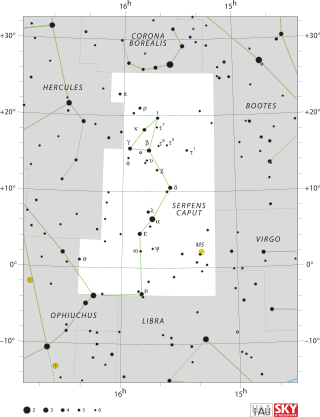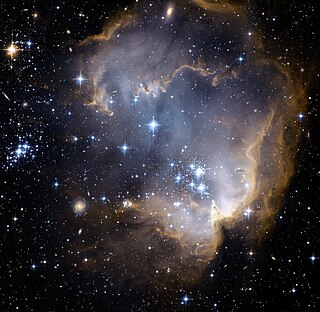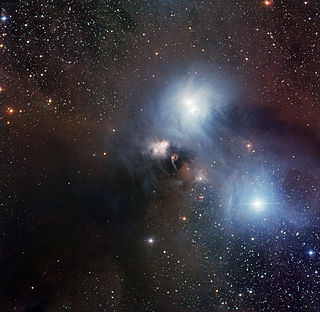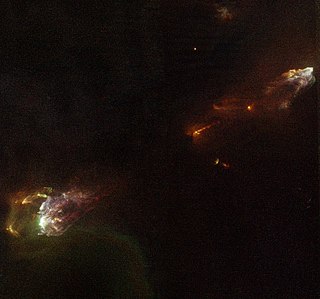This article needs additional citations for verification .(March 2022) |

Variable nebulae are reflection nebulae that change in brightness because of changes in their star.
This article needs additional citations for verification .(March 2022) |

Variable nebulae are reflection nebulae that change in brightness because of changes in their star.

Corona Australis is a constellation in the Southern Celestial Hemisphere. Its Latin name means "southern crown", and it is the southern counterpart of Corona Borealis, the northern crown. It is one of the 48 constellations listed by the 2nd-century astronomer Ptolemy, and it remains one of the 88 modern constellations. The Ancient Greeks saw Corona Australis as a wreath rather than a crown and associated it with Sagittarius or Centaurus. Other cultures have likened the pattern to a turtle, ostrich nest, a tent, or even a hut belonging to a rock hyrax.

Serpens is a constellation in the northern celestial hemisphere. One of the 48 constellations listed by the 2nd-century astronomer Ptolemy, it remains one of the 88 modern constellations designated by the International Astronomical Union. It is unique among the modern constellations in being split into two non-contiguous parts, Serpens Caput to the west and Serpens Cauda to the east. Between these two halves lies the constellation of Ophiuchus, the "Serpent-Bearer". In figurative representations, the body of the serpent is represented as passing behind Ophiuchus between Mu Serpentis in Serpens Caput and Nu Serpentis in Serpens Cauda.

The Helix Nebula is a planetary nebula (PN) located in the constellation Aquarius. Discovered by Karl Ludwig Harding, most likely before 1824, this object is one of the closest of all the bright planetary nebulae to Earth. The distance, measured by the Gaia mission, is 655±13 light-years. It is similar in appearance to the Cat's Eye Nebula and the Ring Nebula, whose size, age, and physical characteristics are similar to the Dumbbell Nebula, varying only in its relative proximity and the appearance from the equatorial viewing angle. The Helix Nebula has sometimes been referred to as the "Eye of God" in pop culture, as well as the "Eye of Sauron".

The Trifid Nebula is an H II region in the north-west of Sagittarius in a star-forming region in the Milky Way's Scutum–Centaurus Arm. It was discovered by Charles Messier on June 5, 1764. Its name means 'three-lobe'. The object is an unusual combination of an open cluster of stars, an emission nebula, a reflection nebula, and a dark nebula. Viewed through a small telescope, the Trifid Nebula is a bright and peculiar object, and is thus a perennial favorite of amateur astronomers.

A proplyd, short for ionized protoplanetary disk, is an externally illuminated photoevaporating protoplanetary disk around a young star. Nearly 180 proplyds have been discovered in the Orion Nebula. Images of proplyds in other star-forming regions are rare, while Orion is the only region with a large known sample due to its relative proximity to Earth.

The Cat's Eye Nebula is a planetary nebula in the northern constellation of Draco, discovered by William Herschel on February 15, 1786. It was the first planetary nebula whose spectrum was investigated by the English amateur astronomer William Huggins, demonstrating that planetary nebulae were gaseous and not stellar in nature. Structurally, the object has had high-resolution images by the Hubble Space Telescope revealing knots, jets, bubbles and complex arcs, being illuminated by the central hot planetary nebula nucleus (PNN). It is a well-studied object that has been observed from radio to X-ray wavelengths.

T Tauri is a variable star in the constellation Taurus, the prototype of the T Tauri stars. It was discovered in October 1852 by John Russell Hind. T Tauri appears from Earth amongst the Hyades cluster, not far from ε Tauri, but it is actually 420 light-years behind it and not a member of the cluster. The cloud to the west of the system is NGC 1555, known more commonly as Hind's Variable Nebula.
Photoevaporation is the process where energetic radiation ionises gas and causes it to disperse away from the ionising source. The term is typically used in an astrophysical context where ultraviolet radiation from hot stars acts on clouds of material such as molecular clouds, protoplanetary disks, or planetary atmospheres.

The Orion molecular cloud complex is a star-forming region with stellar ages ranging up to 12 Myr. Two giant molecular clouds are a part of it, Orion A and Orion B. The stars currently forming within the complex are located within these clouds. A number of other somewhat older stars no longer associated with the molecular gas are also part of the complex, most notably the Orion's Belt, as well as the dispersed population north of it. Near the head of Orion there is also a population of young stars that is centered on Meissa. The complex is between 1 000 and 1 400 light-years away, and hundreds of light-years across.

Sh2-279 is an HII region and bright nebulae that includes a reflection nebula located in the constellation Orion. It is the northernmost part of the asterism known as Orion's Sword, lying 0.6° north of the Orion Nebula. The reflection nebula embedded in Sh2-279 is popularly known as the Running Man Nebula.

The Flame Nebula, designated as NGC 2024 and Sh2-277, is an emission nebula in the constellation Orion. It is about 1350 light-years away. At that distance, the Flame Nebula lies within the Orion B cloud of the larger Orion Molecular Cloud Complex.

The Frosty Leo Nebula is a protoplanetary nebula (PPN) located roughly at 3000 light-years away from Earth in the direction of the constellation Leo. It is a spectral bipolar nebula. Its central star is of optical spectral type K7II, by itself called Frosty Leo. It is unusual in that it has an extremely deep absorption feature at 3.1 μm and is unusually located at more than 900 pc above the plane of our galaxy.(Bourke et al. 2000) Further, as of 1990, it has the only known PPN circumstellar outflow in which crystalline ice dominates the long-wavelength emission spectrum and the only known PPN with point-reflection-symmetric deviations from axial symmetry.

NGC 602 is a young, bright open cluster of stars located in the Small Magellanic Cloud (SMC), a satellite galaxy to the Milky Way. It is embedded in a nebula known as N90.

NGC 2261 is a variable nebula located in the constellation Monoceros. The nebula is illuminated by the star R Monocerotis, which is not directly visible itself.

NGC 6729 is a reflection/emission nebula of the Corona Australis Molecular Cloud in the constellation Corona Australis. It was discovered by Johann Friedrich Julius Schmidt in 1861.

IRC+10420, also known as V1302 Aql, is a yellow hypergiant star located in the constellation of Aquila at a distance of 4-6 kiloparsecs of the Sun.

Cometary knots, also referred as globules, are structures observed in several nearby planetary nebulae (PNe), including the Helix Nebula, the Ring Nebula, the Dumbbell Nebula, the Eskimo Nebula, and the Retina Nebula. They are believed to be a common feature of the evolution of planetary nebulae, but can only be resolved in the nearest examples. They are generally larger than the size of the Solar System, with masses of around 0.00001 times the mass of the Sun, which is comparable to the mass of the Earth. There are about 40,000 cometary knots in the Helix Nebula.

The Herbig-Haro objects HH 1/2 are the first such objects to be recognized as Herbig-Haro objects and were discovered by George Herbig and Guillermo Haro. They are located at a distance of about 1343 light-years in the constellation Orion near NGC 1999. HH 1/2 are among the brightest Herbig-Haro objects in the sky and consist of a pair of oppositely oriented bow shocks, separated by 2.5 arcminutes. The HH 1/2 pair were the first Herbig-Haro objects with detected proper motion and HH 2 was the first Herbig-Haro object to be detected in x-rays. Some of the structures in the Herbig-Haro Objects move with a speed of 400 km/s.